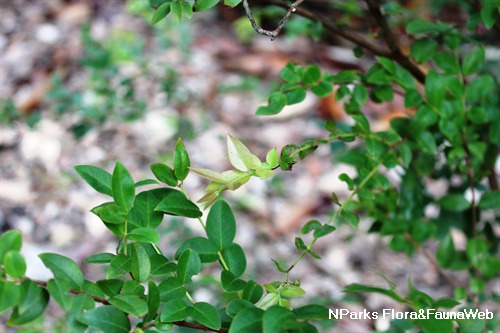
Back
Plinia cauliflora (DC.) Kausel
| Family Name: | Myrtaceae |
| Synonyms: | Myrciaria cauliflora (Mart.) O.Berg, Eugenia cauliflora (Mart.) DC., Myrtus cauliflora |
| Common Name: | Jaboticaba, Brazilian Grape Tree |
Name
Classifications and Characteristics
| Plant Division | Angiosperms (Flowering Seed Plants) (Dicotyledon) |
|---|---|
| Plant Growth Form | Tree (Small (6m-15m)) |
| Lifespan (in Singapore) | Perennial |
| Mode of Nutrition | Autotrophic |
Biogeography
| Native Distribution | South America |
|---|---|
| Native Habitat | Terrestrial |
| Preferred Climate Zone | Tropical |
Description and Ethnobotany
| Growth Form | A small tree or shrub up to 15 m tall. |
|---|---|
| Trunk | The bark is reddish-brown and peeling, revealing the multicolored underbark. |
| Foliage | Leaves are simple and leathery, arranged in opposite pairs, lanceolate to elliptic, measuring 2.5-6 cm long and 1.2-2.5 cm wide. Young leaves are salmon-colored. |
| Flowers | Flowers are small, white with numerous stamens, borne directly on trunks and large branches. |
| Fruit | Fruits are globular, measuring 1.5-4 cm in diameter. Unripe fruits are green and become purplish-black when fully ripe. The fruit resembles a grape, but has a thick skin. Fruit pulp is whitish and edible, embedded with 1 to 5 seeds. |
| Cultivation | Plants do well in deep, rich, well-drained and lightly acidic soils. Once mature, the plant is able to have several crops per year. |
| Ethnobotanical Uses | Edible Plant Parts : Edible Fruits Food (Fruit or Vegetable): Fruits can be eaten raw or processed into jellies, drinks or fermented into wine. |
Landscaping Features
| Desirable Plant Features | Ornamental Fruits, Ornamental Form |
|---|---|
| Landscape Uses | Parks & Gardens |
| Thematic Landscaping | Economic Garden |
Fauna, Pollination and Dispersal
| Fauna Pollination Dispersal Associated Fauna | Bird-Attracting |
|---|
Plant Care and Propagation
| Light Preference | Full Sun |
|---|---|
| Water Preference | Moderate Water |
| Plant Growth Rate | Moderate |
| Rootzone Tolerance | Moist Soils, Well-Drained Soils |
| Pest(s) | Sucking Insects |
| Propagation Method | Seed, Root Cutting, Air-Layering |
Foliar
| Foliage Retention | Evergreen |
|---|---|
| Mature Foliage Colour(s) | Green |
| Mature Foliage Texture(s) | Smooth, Leathery |
| Prominent Young Flush Colour(s) | Pink |
| Foliar Type | Simple / Unifoliate |
Floral (Angiosperm)
| Flower Colour(s) | Cream / Off-White |
|---|---|
| Flower Location | Cauliflorous |
Fruit, Seed and Spore
| Mature Fruit Colour(s) | Black, Purple |
|---|---|
| Seed Quantity Per Fruit | Few (1-5) |
Image Repository
Others
| Master ID | 1924 |
|---|---|
| Species ID | 3216 |
| Flora Disclaimer | The information in this website has been compiled from reliable sources, such as reference works on medicinal plants. It is not a substitute for medical advice or treatment and NParks does not purport to provide any medical advice. Readers should always consult his/her physician before using or consuming a plant for medicinal purposes. |



